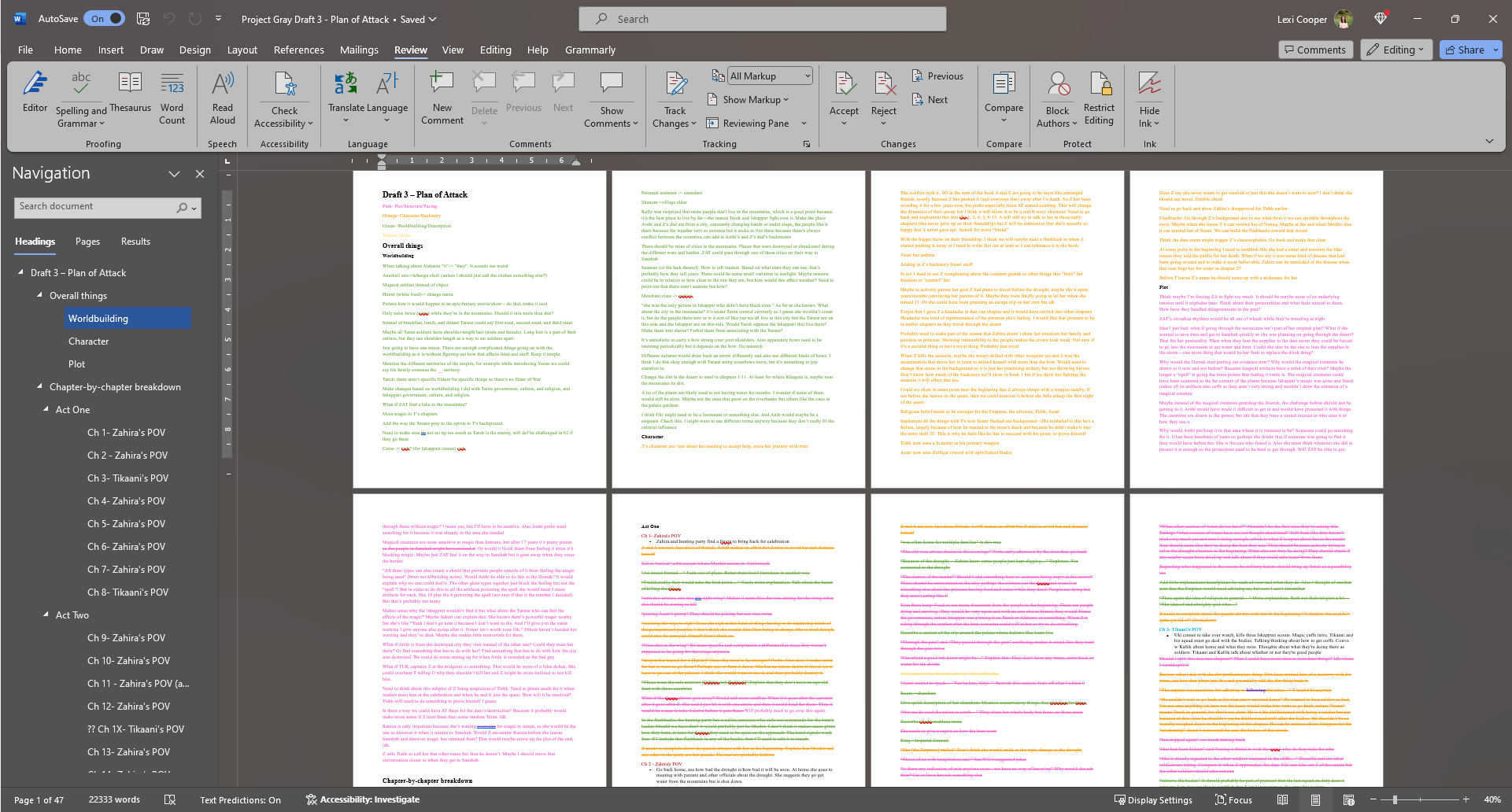So you’ve written your book (congrats!) and realized it’s got some issues. Maybe halfway through you cut an unnecessary character, maybe there’s a big plot hole or your main character’s arc needs a better setup, maybe the beginning is full of info dumping. Regardless of the issues, you’re now wondering, “How do I fix all this? How do I revise this novel?”
It can be daunting. Especially if you’ve never done it before. But you can stop panicking right now because I’ve got a strategy that will help you tackle the beautiful monster you’ve created.
This strategy has evolved over the years as I’ve revised different drafts of different books, and now I finally feel like I have a strategy that helps me get a clear picture of my manuscript and identify issues that I may not have noticed otherwise.
I’m currently using this revision strategy on the third draft of my WIP (work in progress), and it has been a game changer. The book is finally coming together. So, let’s dive right into how to revise a novel.
Take a Break
I know what you’re thinking: “How is the first step to revising a novel taking a break? I haven’t even started.”
It sounds like it doesn’t make sense, but many writers swear by this—myself included. When you finish a draft, you’re too close to the story. You can’t see the big picture because you’ve been in the nitty gritty drafting process for too long.
To revise your novel, you need to take a step back. That’s the only way you’ll be able to see your manuscript for what it is.
I’ve made the mistake of finishing a draft and then diving into revisions a week later. And while I did make improvements in that next draft, I did not do as much as I could have if I had taken a longer break.
If you’re on a deadline, this can be tricky. You may not be able to take a month or two away from your manuscript. As you improve as a writer, you will get better at utilizing shorter breaks (along with knowing what your novel needs for revisions).
But if you can, take a really, really long break. I’m talking months. I took 7 full months between draft 2 and draft 3 of my current WIP. And it helped so much.
What are you supposed to do during that time?
Whatever you want.
Work on a different project (that’s what I do). Or don’t write at all. Refill your creative well by reading. Take up a different hobby. Spend time with friends and family.
Occasionally, during my breaks I work on things related to the story like worldbuilding or character backgrounds, but I try to wait to do that until I’m gearing up to start my next revision.
This is also a great time to give your manuscript to critique partners, your writing group, or beta readers if you’re ready for that step (I usually wait until at least the second draft because I find the feedback more useful at a later stage).
Your break doesn’t have to be 7 months, but I recommend taking as long as you can. If you’re working on another project, you may not even notice the time passing.
Print Your Manuscript
After your break, you’ll be ready to revise your novel with fresh eyes. But it’s important to use those eyes to look at the right thing—a printed manuscript.
Printing out your manuscript might sound like a lot of work (and potentially a lot of pages), but it is great. I’ve done it twice now, and I’m never going back.
I like to print my book in a different font than I wrote it in with space in the margins for notes. To save paper, you can print on both sides—especially helpful if your book is looong.
Reread Your Novel and Take Notes
Once you have your printed manuscript, the next step to revise your novel is to reread it with those fresh eyes I mentioned. You’ll be amazed as you spot problems and come up with solutions.
In the past when I was preparing for revisions, I tried to reread my drafts on my computer. And it never really worked. I usually ended up starting to revise before I was really ready to. But it’s important to get a clear picture of the story before you start to revise.
When you print your manuscript, it’s physically impossible to revise it while you’re reading. Instead, you have to write yourself notes, identifying problems or describing the edits you’re going to make.
I love doing this. I break out the highlighters and assign a different color for each type of problem: plot, worldbuilding, and character. Most issues will fit into one of these categories, but you can break it into as many types as you want.
As I read through, I highlight an area according to its category and make a note in the margin. Sometimes these notes have solutions to problems, and sometimes they just say things like “Why does this character do this?!” or “Research this!”
Read through the whole manuscript this way. It’s the best way to see the story as a whole and refamiliarize yourself with it. Once you’ve read it, it’s time to create your plan of attack.

Convert Your Notes into a Plan of Attack
I admit it: I am a thief myself. I stole this part of my revision plan from Susan Dennard. You can find her guide to revisions here.
My version is a little different though. I believe she writes everything onto notecards (which you’re welcome to do) and organizes them by the type of problem before finding solutions.
What I do from here is create a document on my computer called “Draft X – Plan of Attack” (she’s right; it’s so empowering to call it that). In this document, I list all the chapters or scenes with brief descriptions of what happens in each scene. If you already have an outline, you can use that (as long as it is up to date with what actually happens in the story).
Then I type up all my notes from my printed manuscript, putting them under their corresponding scene. Not only is this convenient to have on your computer so you don’t have to lug around the printed manuscript, but it only takes a couple of days (potentially less depending on how much time you can spend at once) to type up the notes, meaning you’re reading through all the notes in a short period. This will give you a great overview of all the issues in the story and help you see how they connect.
In this document, I type the notes in their corresponding colors. I also have sections at the top of the document for notes on overarching problems that I’ve noticed either in the read-through or when I was typing up the notes.
As you type the notes, you’ll likely start to think of solutions. Type those up too. It’s okay if you don’t have solutions to all of the problems yet, but you should have a good idea of what isn’t working at this point.
Enact Your Plan of Attack
It’s time to put your revision plan into action and revise that novel.
I do this by going through chronologically chapter by chapter and scene by scene. I’ve never been good at hopping around to different scenes in the manuscript, but you can do that, focusing on one type of problem at a time, if you work better that way.
Open a new document, along with your Plan of Attack and the last draft.
I used to copy and paste a chapter into my new document, revise it, and then move on to the next chapter. But I found I was leaving too much the same.
I’d heard that some writers retype every word (or replace them with new ones as they type). I tried that at the beginning of the draft I’m currently working on, but it was taking forever, and I lost patience.
So instead, I copy and paste paragraph by paragraph, sometimes sentence by sentence, evaluating whether each sentence still works and retyping and rearranging them as necessary. This has given me the freedom to make lots of big changes, deleting sections that feel tedious, adding in more details where they’re needed, changing dialogue to make it sound more in character, etc.
Of course, this doesn’t work for every scene. But I don’t feel so bad about cutting scenes or rewriting them. This strategy has really helped me feel free to make changes that improve the story. I don’t feel the need to hold onto things that I liked that weren’t serving the story.
As I do this, I’m constantly consulting my Plan of Attack document. Every time I address an issue that I identified in the read-through or every time an issue becomes irrelevant as I rewrite or cut scenes, I cross it out with the strikethrough feature (very satisfying).
Go Back Through for Final Adjustments and Tweaks
If you went through chronologically as I do, once you finish the book, there are bound to be a few loose ends for you to tie up. As I revise, I often have ideas about things to add or change in scenes I’ve already passed. I write all these down in the Plan of Attack document so I don’t forget them.
Now that you’ve finished, it’s time to go back to address all those issues and do a final check for this draft. However, if you find yourself exhausted with this draft, you can leave these for the next draft.
That’s it! I hope you find this guide to revising a novel useful. Keep in mind that everyone’s process is different, and you may have to experiment to find what works best for you when you revise your novel.
Happy writing!





